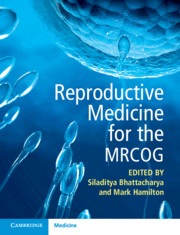Book contents
- Reproductive Medicine for the MRCOG
- Reproductive Medicine for the MRCOG
- Copyright page
- Contents
- Contributors
- Chapter 1 Epidemiology and Initial Assessment of the Infertile Patient
- Chapter 2 Disorders of Ovulation and Reproductive Endocrine Disorders Associated with Infertility
- Chapter 3 Endometriosis
- Chapter 4 Uterine and Tubal Causes of Infertility
- Chapter 5 Andrology and Infertility
- Chapter 6 Unexplained Infertility
- Chapter 7 Assisted Reproduction
- Chapter 8 Adjuvants in Assisted Reproduction
- Chapter 9 Laboratory Procedures for Assisted Reproduction
- Chapter 10 Fertility Preservation
- Chapter 11 Third-Party Reproduction
- Chapter 12 Managing Ethical Dilemmas in Reproductive Medicine
- Chapter 13 Evidence-Based Reproductive Medicine
- Chapter 14 The Organisation of Services and Quality Assurance in Fertility Practice
- Index
- References
Chapter 10 - Fertility Preservation
Published online by Cambridge University Press: 25 February 2021
- Reproductive Medicine for the MRCOG
- Reproductive Medicine for the MRCOG
- Copyright page
- Contents
- Contributors
- Chapter 1 Epidemiology and Initial Assessment of the Infertile Patient
- Chapter 2 Disorders of Ovulation and Reproductive Endocrine Disorders Associated with Infertility
- Chapter 3 Endometriosis
- Chapter 4 Uterine and Tubal Causes of Infertility
- Chapter 5 Andrology and Infertility
- Chapter 6 Unexplained Infertility
- Chapter 7 Assisted Reproduction
- Chapter 8 Adjuvants in Assisted Reproduction
- Chapter 9 Laboratory Procedures for Assisted Reproduction
- Chapter 10 Fertility Preservation
- Chapter 11 Third-Party Reproduction
- Chapter 12 Managing Ethical Dilemmas in Reproductive Medicine
- Chapter 13 Evidence-Based Reproductive Medicine
- Chapter 14 The Organisation of Services and Quality Assurance in Fertility Practice
- Index
- References
Summary
Men, women and children with cancer and other fertility-threatening conditions now have the option to preserve fertility which is otherwise at risk. Sperm and embryo cryopreservation is established and successful in adults, and the development of oocyte vitrification has greatly improved the potential to cryopreserve unfertilised oocytes. Techniques for children and teenagers are still under development and bring specific challenges, including ethical, practical and scientific issues. Cryopreservation of ovarian cortical tissue with later replacement has resulted in livebirths and is no longer regarded as experimental in many countries. For prepubertal boys, testicular biopsy cryopreservation is possible, but how that tissue might be used in the future is unclear. Non-cryostorage options aim to minimise treatment gonadotoxicity but none are reliable. Decision making for all these approaches needs assessment of the individual’s risk of fertility loss and is made at a time of emotional distress and within time constraints. The possibility of requiring surrogacy, storage time limits and alternatives including the use of donor gametes and adoption should also be discussed.
- Type
- Chapter
- Information
- Reproductive Medicine for the MRCOG , pp. 113 - 122Publisher: Cambridge University PressPrint publication year: 2021



